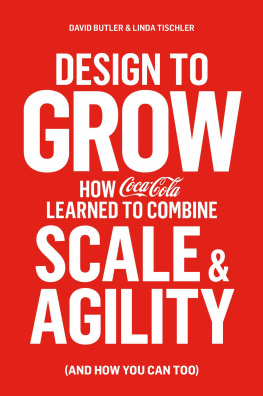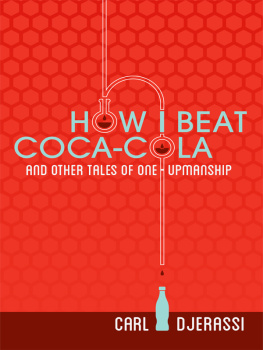David Butler - Design to grow: how Coca-Cola learned to combine scale & agility (and how you can too)
Here you can read online David Butler - Design to grow: how Coca-Cola learned to combine scale & agility (and how you can too) full text of the book (entire story) in english for free. Download pdf and epub, get meaning, cover and reviews about this ebook. City: Kennett Square, PA, year: 2015, publisher: Soundview Executive Book Summaries;Simon & Schuster, genre: Business. Description of the work, (preface) as well as reviews are available. Best literature library LitArk.com created for fans of good reading and offers a wide selection of genres:
Romance novel
Science fiction
Adventure
Detective
Science
History
Home and family
Prose
Art
Politics
Computer
Non-fiction
Religion
Business
Children
Humor
Choose a favorite category and find really read worthwhile books. Enjoy immersion in the world of imagination, feel the emotions of the characters or learn something new for yourself, make an fascinating discovery.
- Book:Design to grow: how Coca-Cola learned to combine scale & agility (and how you can too)
- Author:
- Publisher:Soundview Executive Book Summaries;Simon & Schuster
- Genre:
- Year:2015
- City:Kennett Square, PA
- Rating:4 / 5
- Favourites:Add to favourites
- Your mark:
- 80
- 1
- 2
- 3
- 4
- 5
Design to grow: how Coca-Cola learned to combine scale & agility (and how you can too): summary, description and annotation
We offer to read an annotation, description, summary or preface (depends on what the author of the book "Design to grow: how Coca-Cola learned to combine scale & agility (and how you can too)" wrote himself). If you haven't found the necessary information about the book — write in the comments, we will try to find it.
Design to grow: how Coca-Cola learned to combine scale & agility (and how you can too) — read online for free the complete book (whole text) full work
Below is the text of the book, divided by pages. System saving the place of the last page read, allows you to conveniently read the book "Design to grow: how Coca-Cola learned to combine scale & agility (and how you can too)" online for free, without having to search again every time where you left off. Put a bookmark, and you can go to the page where you finished reading at any time.
Font size:
Interval:
Bookmark:
Join our mailing list and get updates on new releases, deals, bonus content and other great books from Simon & Schuster. CLICK HERE TO SIGN UP or visit us online to sign up at
eBookNews.SimonandSchuster.com

Contents
For Allen, Claudia, Stelle, and RubyIm a lucky man. David
For Hank, Melissa, and BenIm thrice blessed. Linda
If you want to build a ship, dont drum up the men to gather wood, divide the work, and give orders. Instead, teach them to yearn for the vast and endless sea.Antoine de Saint-Exupry
Preface
S CALE AND AGILITY. In todays volatile and rapidly changing world, these are the two essentials that every company needs to grow and remain relevant.
If youre a big, established company, youve got scale, which enables you to expand almost effortlessly from Boston to Bangalore. Over time, youve built up powerful assetsexpertise, brands, customers, distribution channels, relationshipsthat most startups could only dream about. Scale is not your problem. Your problem is agilityyou must be smarter, faster, leaner than the startup thats got your industry in its crosshairstargeted for disruption.
How can you grow (gain market share, increase your brands relevance, and generate revenue growth) with the speed and flexibility of a startup? Every big, established company, organization, and even government is at risk of being disrupted, having a so-called Kodak Moment, watching its industry upended and its competitive advantagesthe moats that have protected it for decadesdisappear overnight.
If youre in a startup, youve got a different problem. Youve got agility, actually, nothing but agility. Trying new business models, repositioning your company, developing new features, or even whole new products, within daysthings big companies can only dream aboutare not your problem. For you, building the right team, deciding which metrics matter, acquiring customers, and securing funding are what keep you up at night. Scale is your problemdoing what it takes to expand your startup into new geographies, including the land of profitability, is your challenge. Thats why most startups failonly a dispiriting one out of ten succeeds.
What if there were something that could help you grow, avoid disruption, and even take giant steps forward? What if there were something that could help you create both scale and/or agility?
There isits called design .
And thats what this book is abouthow The Coca-Cola Company uses design to grow, and how the lessons it learned can help other companies, regardless of size, industry, or geography, do the same.
For over a century, Coca-Cola has used design to scale to over two hundred countries, build seventeen billion-dollar brands, partner with more than twenty million retail customers, and sell close to two billion products a day. But the company is still learning. Over the last decade, it has focused on mastering how also to use design to create agilitysomething most established companies, including Coca-Cola, struggle with.
Well deconstruct this journey by demystifying the often confusing language of design into a set of plain-spoken, easy-to-understand principles. Along the way, well explore examples from around the world and across different parts of the companymango growing in Kenya, packaging in Tokyo, retail shops in Bogot, advertising in Cape Town, and social fountain machines in the United Statesto make it easier to understand the role design can play in helping one of the largest companies on the planet become nimbler and more adaptable to a complex and changing world. The stories themselves may be unique to Coca-Cola, but the challenges they describe are universal.
How to use this book
A few words about how this book is organized. Part 1 explains how to design for scale, and shows how The Coca-Cola Company used design across its business to create a $170 billion, global brand.
In chapter 1 we grapple with the question, What is design? then show how design creates value and what it looks like to design on purpose.
In chapter 2, we investigate how The Coca-Cola Company used design strategically to scale Coca-Cola into one of the most, if not the most, ubiquitous brands on the planet.
In chapter 3, we look at three realities that create the new normal of todays marketplace: wicked problems, the changes unleashed by the after-Internet world, and the need to create shared value. There are, of course, other factors, but these three have created a new level of external complexity, challenging every companys ability to grow.
In part 2, we discuss what it takes to join the Billion-Dollar Brand Club, and explore why its getting harder than ever for established companies to maintain their status as part of this elite group. Well examine how startups design for agility and how big, established companies can too.
In chapter 4, well explain how design can actually help any company learn to fail fast, and adapt to stay ahead of the competition. Well show how The Coca-Cola Company uses design to create adaptability from its 5-Note Melody to its manual distribution systems in Africa to the redesign of hundreds of bodegas in Latin America.
In chapter 5, well see how designing modular systems is one way for a company to stay agile enough to survive and thrive. Well look at three examples from Coca-Cola: its global juice visual identity system, a high-density mango growing initiative, and the development of the Freestyle drink machine, to see how designing modular systems really works.
In chapter 6, we see why designing open systems, such as Wikipedia, allows for greater collaboration, both within a company and with a companys stakeholders. That process, it turns out, can not only help in uncovering the best talent and ideas, but can result in cost savings along the way. We look at the development of the Coca-Cola Design Machine, its 5by20 global commitment to empower women entrepreneurs, and its initiatives around global water use as examples of open systems in action.
Finally, in the epilogue, we consider what the future will look like in a world where design is democratized. Well also explore what big companies can learn from startups to help them avoid significant disruption, and what startups can learn from big companies that would let them beat that dismal startup failure rate. Will the next wave of innovationbuilding scale-upsbe the answer for both ends of the business spectrum?
Throughout the book, we offer lessons that any company can use to grow and thrive, along with suggestions as to how you can use our road-tested ideas for getting everybody in your company on board.
In The Deep End, we provide references for anyone who wants to delve further into the ideas presented here, as well as the never-before-published Designing on Purpose manifesto that was my Jerry Maguire moment at the company, and the seed for this book.
In the course of this book, well go behind the scenes of The Coca-Cola Companys operations, ranging from how the carpet industry helped it make the decision on what shade of blue to use for the Dasani bottle to how its turning local biowastefrom sugar cane stalks in Brazil to tree bark in Russiainto PlantBottle Packaging.
Most of these problems are, of course, specific to Coca-Cola, but every business can learn from the way the company used design to solve them.
PART 1
Designing for Scale
T he first week of November 2013 saw a flurry of unusually compelling stories in the business news. Tesla suffered another battery fire, prompting fears of a recall. The Feds nailed a hedge-fund titan with a fondness for insider trading. The stock market hit a new high. However, even amid such provocative headlines, two events stood out: the shuttering of a once-mighty retail empire, and the stratospheric stock market debut of a seven-year-old Internet darling.
Next pageFont size:
Interval:
Bookmark:
Similar books «Design to grow: how Coca-Cola learned to combine scale & agility (and how you can too)»
Look at similar books to Design to grow: how Coca-Cola learned to combine scale & agility (and how you can too). We have selected literature similar in name and meaning in the hope of providing readers with more options to find new, interesting, not yet read works.
Discussion, reviews of the book Design to grow: how Coca-Cola learned to combine scale & agility (and how you can too) and just readers' own opinions. Leave your comments, write what you think about the work, its meaning or the main characters. Specify what exactly you liked and what you didn't like, and why you think so.









